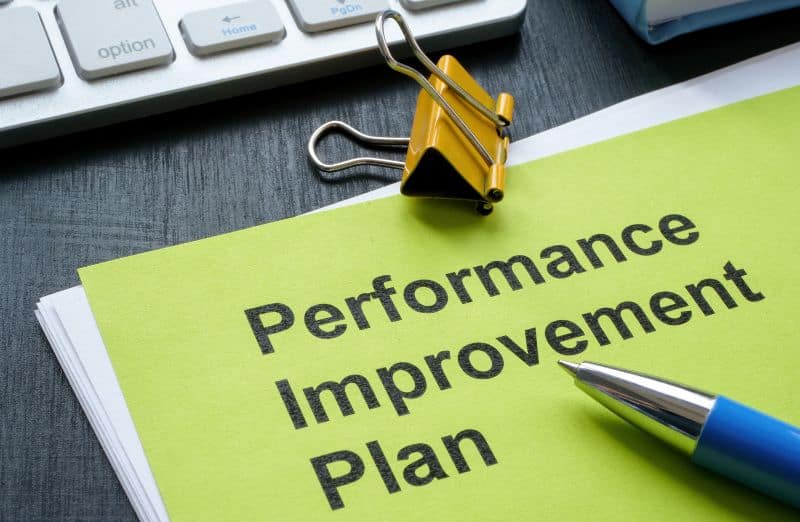Understanding Underperformance
Underperformance is a common issue that affects many organizations, resulting in decreased productivity, low employee morale, and poor customer satisfaction. It is essential for managers to address underperformance promptly and effectively to prevent it from becoming a long-term problem. Underperformance can be caused by various factors, including inadequate training, poor management style, and personal issues. In this section, we will discuss the importance of addressing underperformance and provide an overview of the steps that managers can take to manage underperformance.
Reframing Underperformance as a Growth Opportunity
Underperformance is an inevitable part of any workplace—but it doesn’t have to be a negative one. Instead of approaching it with dread or defensiveness, organizations can choose to see underperformance as a moment of opportunity. It offers a chance to rebuild trust, realign goals, and even reignite motivation in individuals who may have drifted off course. By focusing on growth opportunities, organizations can implement best practices aimed at preventing underperformance before it becomes a significant issue.
When leaders treat underperformance as a collaborative challenge instead of a punitive situation, the culture begins to shift. Employees become less fearful of feedback and more open to growth. The result is not just improved performance, but a more resilient, self-aware team dynamic.
What Does Underperformance Actually Look Like?
Underperformance isn’t always dramatic or disruptive. Often, poor performance shows up in subtle ways—missed deadlines, declining engagement in meetings, repeated mistakes, or minimal effort in collaborative tasks. It can also manifest as a lack of enthusiasm or emotional withdrawal from projects.
The important thing is recognizing that not all underperformance is the same. A previously high-achieving employee who suddenly seems distracted may be experiencing personal stress. Another who struggles to meet expectations from the start may be dealing with a skills mismatch. Spotting these differences is critical to tailoring your response effectively.
Common Root Causes of Workplace Underperformance
Jumping straight to blame when someone isn’t delivering is not only unhelpful—it’s unfair. The causes of underperformance are often complex and layered. Common drivers include unclear expectations, inadequate training, low role clarity, lack of engagement, or even cultural misalignment with the team.
There may also be external causes—health challenges, financial stress, or family pressures. Without understanding the root cause, any performance intervention is likely to miss the mark. Leaders must first ask: “Why is this happening?” before deciding “What should we do?”
Distinguishing Between Skill Gaps and Motivation Issues
Performance can be affected by either a lack of ability or a lack of will. The first step in resolving underperformance is understanding whether the challenge is technical or emotional.
A skill gap might show up as slow output, errors, or reliance on others. A motivation issue, however, might involve minimal participation, disengagement, or reluctance to take ownership. Addressing skill gaps may require training or reassigning responsibilities, while motivation issues often call for deeper engagement strategies or realignment of roles to ignite intrinsic drive. Understanding whether the issue is technical or emotional can help in mitigating the consequences of underperformance on team dynamics and overall productivity.
Why Early Intervention Matters
Timing is everything. When underperformance is ignored, it tends to fester and grow—affecting team morale, project timelines, and ultimately, the employee’s own sense of self-worth. Addressing performance issues early allows for gentle course correction, rather than needing a drastic overhaul later on.
By intervening at the first signs—before resentment or defensiveness builds—you can maintain the team’s psychological safety, open communication, and better outcomes for everyone involved.
Using Data and Observation, Not Assumptions
Too often, underperformance is assumed based on vague impressions or gut feelings. But real performance conversations should be grounded in objective facts. This includes KPIs, attendance logs, client feedback, peer input, and other quantifiable measures.
Equally important is observation. Track patterns, not one-off incidents. Look for consistent behaviors over time and avoid labeling someone based on a single bad week. Using data keeps the conversation fair, focused, and productive. Objective data helps in understanding how underperformance can impact overall business productivity and employee morale.
Avoiding Bias in Identifying Underperformance
Bias can cloud even the best intentions. Proximity bias, affinity bias, or cultural stereotypes may lead managers to misinterpret someone’s behaviors or capabilities. For example, introverts may be unfairly seen as disengaged, while expressive personalities may be mistaken for highly productive.
Ensure all evaluations go through an equity lens. Are you giving the same opportunities and feedback to everyone? Are performance reviews based on outcomes or personalities? Inclusive leaders regularly check their bias and seek input from diverse perspectives, often requiring necessary training to effectively manage underperformance.
How to Prepare for a Constructive Performance Conversation
Before initiating a performance conversation, preparation is essential. Rushing into a talk with vague concerns and no structure can backfire. Instead, come equipped with:
- Specific observations backed by data
- A clear objective (Is it to understand? To solve? To support?)
- A calm and neutral tone
- An openness to listen and learn
- Assess whether the employee’s strengths are being effectively utilized in their current role
Consider your language as well. Avoid accusations (“You don’t care about your work”) and opt for curiosity (“I’ve noticed a shift—what’s going on for you lately?”). Preparedness creates confidence and empathy, both crucial for productive dialogue.
Creating a Safe Space for Honest Dialogue
Performance conversations only succeed when there’s psychological safety. If employees feel judged, cornered, or shamed, they’ll shut down—or worse, become defensive. Instead, create an environment that says, “This is about growth, not punishment.”
This means holding the conversation privately, using neutral body language, and setting a calm tone from the start. Emphasize your intention: to help, support, and explore solutions together. Safe spaces invite vulnerability—and vulnerability invites growth.
Listening First: The Power of Empathy in Tough Talks
When employees feel heard, they feel respected. That respect can be the bridge between disengagement and re-engagement. Begin with listening—not lecturing. Ask questions like:
- “What’s been challenging for you lately?”
- “Is anything outside of work affecting your focus?”
- “How do you feel about your role right now?”
- “How can we provide support to help you address any personal or professional challenges?”
Often, the issue isn’t visible on the surface. Empathy uncovers truths, and those truths pave the way for customized, compassionate solutions.
Setting Clear Expectations and Measurable Goals
Clarity is performance’s best friend. When expectations are vague or moving, even the most capable employee may fall short. Use SMART goals—Specific, Measurable, Achievable, Relevant, and Time-bound—to define what success looks like.
Discuss these together and document them. This eliminates ambiguity, builds mutual accountability, and turns abstract complaints into achievable targets. If performance does not improve despite clear expectations and support, managers may need to inform employees that disciplinary action could be taken.
Collaborative Performance Improvement Plans (PIPs)
Performance Improvement Plans (PIPs) are often seen as disciplinary, but when framed collaboratively, they can be powerful growth tools. Rather than delivering a rigid mandate, co-create the PIP with your employee:
- Identify key areas to improve
- Set milestones and timelines
- Include support mechanisms (mentors, training, tools)
- Identify next steps to empower the employee to take ownership of their development
This shared approach shifts the tone from confrontation to collaboration, increasing the chances of success.
Providing Coaching Instead of Just Criticism
Criticism tells someone what’s wrong. Coaching helps them understand why—and how to get it right. A coaching approach is forward-focused. It assumes people want to succeed and need support, not punishment.
Use open-ended questions, offer feedback with care, and encourage problem-solving. Coaching empowers employees to own their journey—and that ownership is the foundation of long-term improvement. Use specific examples to illustrate areas for improvement and guide the coaching process.
When to Send in the Cavalry: The AI Coaching Revolution

In today’s fast-paced work environment, managing underperformance effectively requires innovative solutions. Enter the AI Coaching Revolution, where technology meets human potential to transform how we approach employee development. Spinify’s AI Coaching Agent is at the forefront of this revolution, offering real-time insights and personalized coaching to help underperforming employees improve their performance.
The AI Coaching Agent analyzes performance data, identifies patterns, and provides actionable feedback tailored to each employee’s needs. This allows managers to address performance issues proactively, offering support and guidance before they escalate. With AI-powered coaching, employees receive continuous, objective feedback, helping them align with expected standards and improve their skills.
By integrating AI coaching into performance management, organizations can enhance business productivity, boost employee morale, and foster a culture of continuous improvement. The AI Coaching Revolution is not just about technology—it’s about empowering employees to reach their full potential and succeed in their roles.
Micro-Feedback for Macro-Impact
Feedback doesn’t have to be formal to be powerful. A quick Slack message, a passing comment, or a one-sentence email can reinforce effort and guide behavior. The more frequently feedback is given, the less overwhelming it feels—and the faster performance improves.
Regular micro-feedback helps in developing an employee’s skills and aligning their performance with organizational goals.
Make it a habit. Normalize it. And remember, it’s the little nudges that shape big outcomes.
Aligning Employee Strengths to Role Demands
Sometimes, underperformance isn’t about a lack of ability—but a misalignment between strengths and responsibilities. An employee who thrives on collaboration may struggle in a solitary role. A strategic thinker may feel boxed in by highly repetitive tasks. When someone’s talents don’t align with their duties, motivation, engagement, and performance can all suffer. Ensure that clear procedures are in place to assess and realign employee strengths with their responsibilities.
Start by evaluating the individual’s natural strengths using tools like CliftonStrengths or DISC assessments. Then, where possible, restructure their responsibilities to better fit what they do well. Aligning roles with strengths not only boosts individual performance but also increases retention and morale across the board.
Encouraging Peer Support and Team Accountability
Performance doesn’t happen in isolation. Often, an underperforming employee can benefit significantly from positive peer pressure and team involvement. Create a culture where team members:
- Cheer each other on
- Share what works
- Offer a hand when someone struggles
This doesn’t mean shifting responsibility—but rather using peer accountability to build resilience and motivation. Cross-functional check-ins, buddy systems, or team KPIs can be powerful tools for pulling someone out of a slump and reminding them they’re not alone.
Transforming Underperformance into Development Opportunities
Development opportunities are essential for helping underperforming employees improve their performance. Providing additional training, coaching, and mentoring can help employees develop the skills and knowledge they need to succeed in their roles.
Managers should identify the root cause of underperformance and provide targeted support to address the issue. This can include providing constructive feedback, setting clear expectations, and creating a performance improvement plan. By providing development opportunities, managers can help underperforming employees improve their performance and achieve their full potential.
Crafting a Dynamic Action Plan for Lasting Performance Improvement

Creating an action plan is a crucial step in managing underperformance. The plan should outline specific goals, objectives, and timelines for improvement. It should also identify the resources and support that the employee will need to achieve their goals. Managers should work with the employee to create the action plan, ensuring that it is realistic and achievable. The plan should also include regular check-ins and progress updates to ensure that the employee is on track to meet their goals. By creating a comprehensive action plan, managers can help underperforming employees improve their performance and achieve success.
When Mental Health or Burnout Is a Factor
Burnout and mental health challenges are silent performance killers. An employee might be doing their best just to show up—let alone excel. It’s important to be attuned to the warning signs:
- Sudden disengagement
- Increased absenteeism
- Emotional outbursts or extreme fatigue
Setting realistic performance goals can help employees manage their workload and reduce the risk of burnout.
If mental health is suspected, approach the issue gently. Offer time off, provide access to mental health resources, and remove the stigma from asking for help. Remember: supporting mental health is not a nice-to-have—it’s essential leadership.
Using Recognition to Reinforce Positive Change
Once an employee begins improving, however small the step, acknowledge it quickly and publicly (when appropriate). Recognition reinforces effort, boosts morale, and creates positive momentum. Even a simple “I noticed you stayed focused all week—great job!” can make a major impact.

Whenever possible, provide recognition in person to make it more impactful and personal.
Recognition shouldn’t only be reserved for high performers—it should be used to encourage progress at all levels. When people feel their hard work is seen and appreciated, they become more committed to delivering at their best.
Checking in Consistently (Not Just at Review Time)
Consistency is what makes performance management proactive instead of reactive. Don’t wait for quarterly reviews to have meaningful conversations. Instead, schedule regular check-ins—even if they’re informal.
These meetings are opportunities to:
- Celebrate small wins
- Course-correct early
- Reconnect emotionally
- Monitor the employee’s progress and provide regular feedback to support their development
Consistency creates stability. It also builds trust, making tough conversations feel like guidance, not punishment.
Training Managers to Handle Underperformance with Confidence
Not every manager naturally knows how to handle underperformance. Many avoid the issue, hoping it resolves on its own, or approach it too harshly. That’s why manager training is non-negotiable.
Equip your leaders with skills in:
- Active listening
- Feedback delivery
- Conflict resolution
- Coaching techniques
- Holding individuals responsible for their progress and improvements
A confident, compassionate manager can turn a struggling team member into a high performer—and improve overall team dynamics in the process.
The Role of HR in Supportive Performance Management
HR isn’t just there to “clean up” when things go wrong. They should be proactive partners in creating fair, structured, and empathetic approaches to performance issues. HR can:
- Mediate sensitive conversations
- Help design fair documentation processes
- Offer legal and psychological insight
- Track progress and improvement
- Assess and improve the work environment to support employee performance
When HR is included early and often, performance plans are more effective—and employees feel safer, not scrutinized.
Knowing When It’s Time to Escalate or Reassign
Despite best efforts, some situations don’t improve. Maybe the employee is in the wrong role—or even the wrong company. If so, the kindest thing you can do is act with clarity and compassion. Escalation doesn’t mean you’ve failed—it means you’ve recognized that a change is necessary.
Before making that call, look for signs that the employee is showing signs of underperformance and consider all growth-oriented options. Exhaust every growth-oriented option. But when the time comes, have the courage to reassign or release the employee with dignity and empathy.
How to Document Underperformance Fairly and Objectively
Documentation is crucial—not just to protect your organization, but to ensure fairness for the employee. Make sure records are:
- Fact-based
- Time-stamped
- Free of emotional or speculative language
Documentation should include what was discussed, what support was offered, and how the employee responded. This builds transparency and provides a roadmap for future reference—whether the situation improves or escalates. Addressing performance issues may require more than one conversation to be effective, ensuring both parties understand the action points and progress necessary for improvement.
Conquering Common Challenges in Managing Underperformance
Managing underperformance can be challenging, and there are several common obstacles that managers may face. These can include resistance from the employee, lack of resources, and difficulty in addressing personal issues. To overcome these obstacles, managers should approach the situation with empathy and understanding. They should also be transparent and communicative, providing regular updates and feedback to the employee.
Additionally, managers should be aware of labor laws and regulations, ensuring that they follow a fair and legal dismissal process if necessary. By being aware of these common obstacles and taking steps to overcome them, managers can effectively manage underperformance and improve employee performance.
Turning Around a Struggling Employee: Real-World Success Tips
Redemption stories are real. Many underperformers just need the right support, the right motivation, and a leader who believes in their potential. Real-world turnarounds often come down to:
- A candid conversation that sparked reflection
- A mentor who showed consistent care
- A change in role or responsibilities
- A leader who kept showing up—even when results didn’t
- A leader who took the time to understand and develop the employee’s skill set
When underperformance is approached with patience and persistence, it can evolve into a career-defining comeback—for both the employee and the leader guiding them.
Underperformance Is Not the End—It’s a Chance to Lead
Every leader will face underperformance on their team. The difference lies in how they choose to respond. Do they ignore it, fear it, or blame it away? Or do they use it as a moment to connect, realign, and empower?
Handled with care, underperformance becomes an inflection point—a test of leadership, empathy, and accountability. So don’t just correct the problem. Lead through it. Because some of your greatest team successes might begin with a conversation you were once afraid to have. Terminating underperforming employees should be considered a last resort, with proper documentation and evidence to justify such decisions.
🎯 Want to empower your leaders to turn underperformance into high-performance moments? Book a free personalized demo with Spinify today! Discover how we can help track, coach, and recognize improvement in real time.




